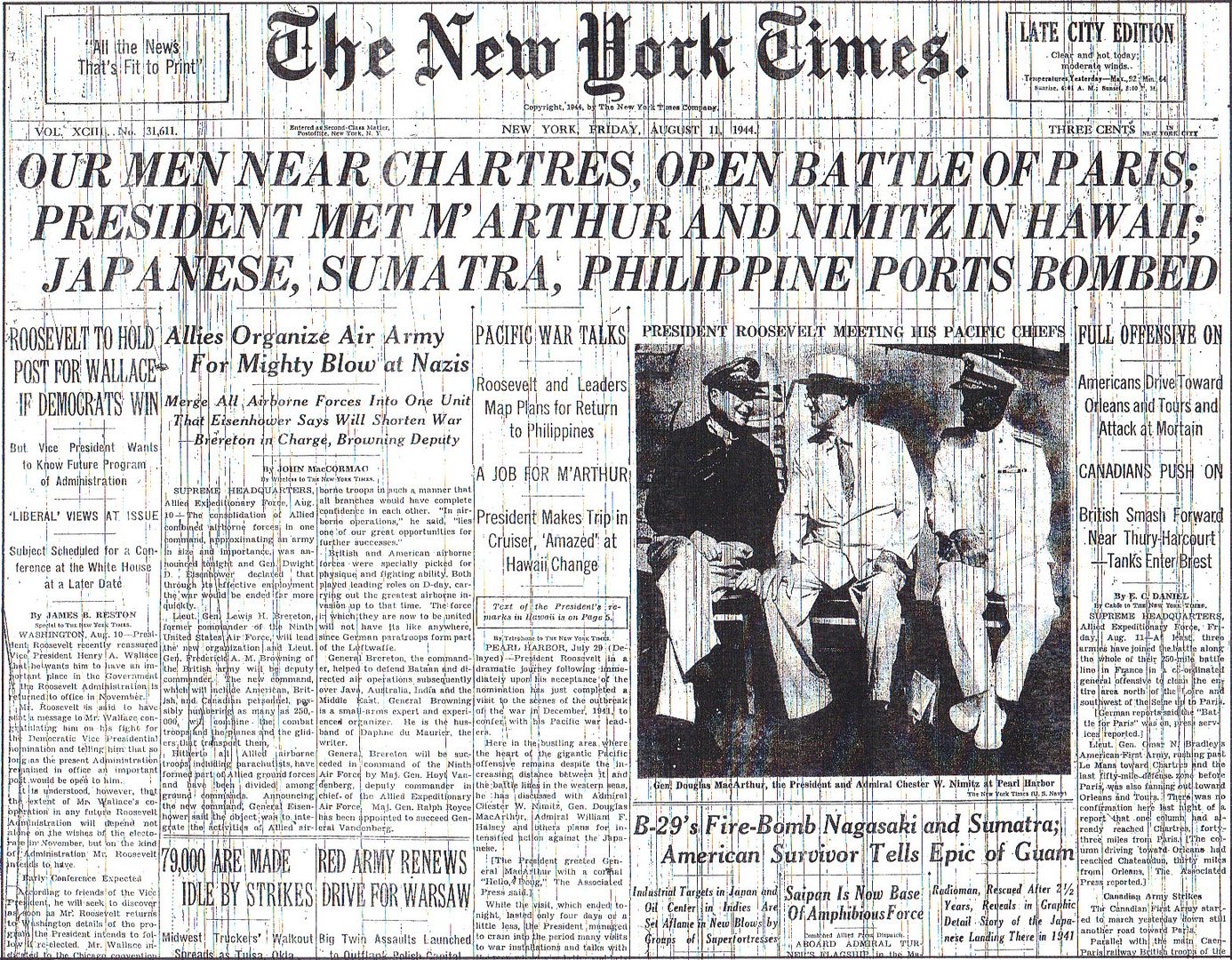
Posted on 08/11/2014 4:07:31 AM PDT by Homer_J_Simpson

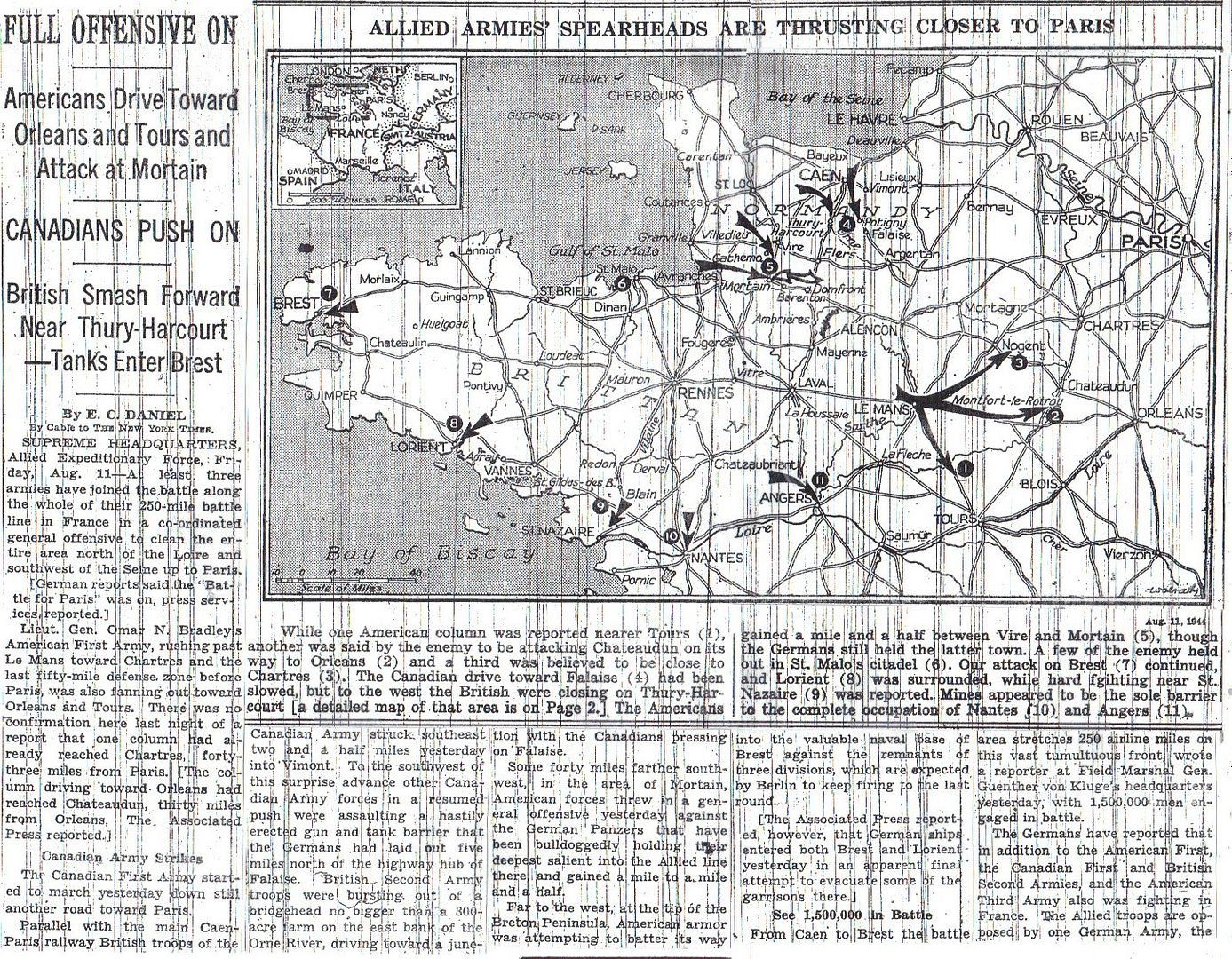
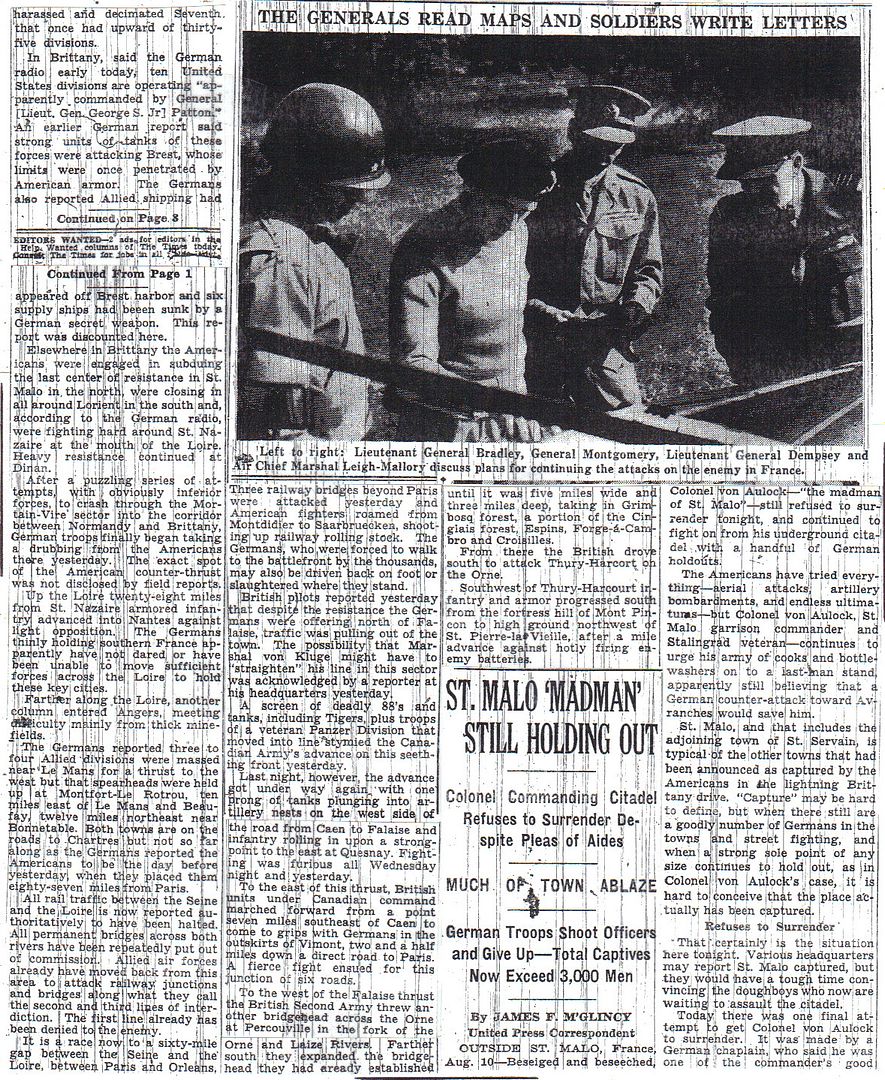
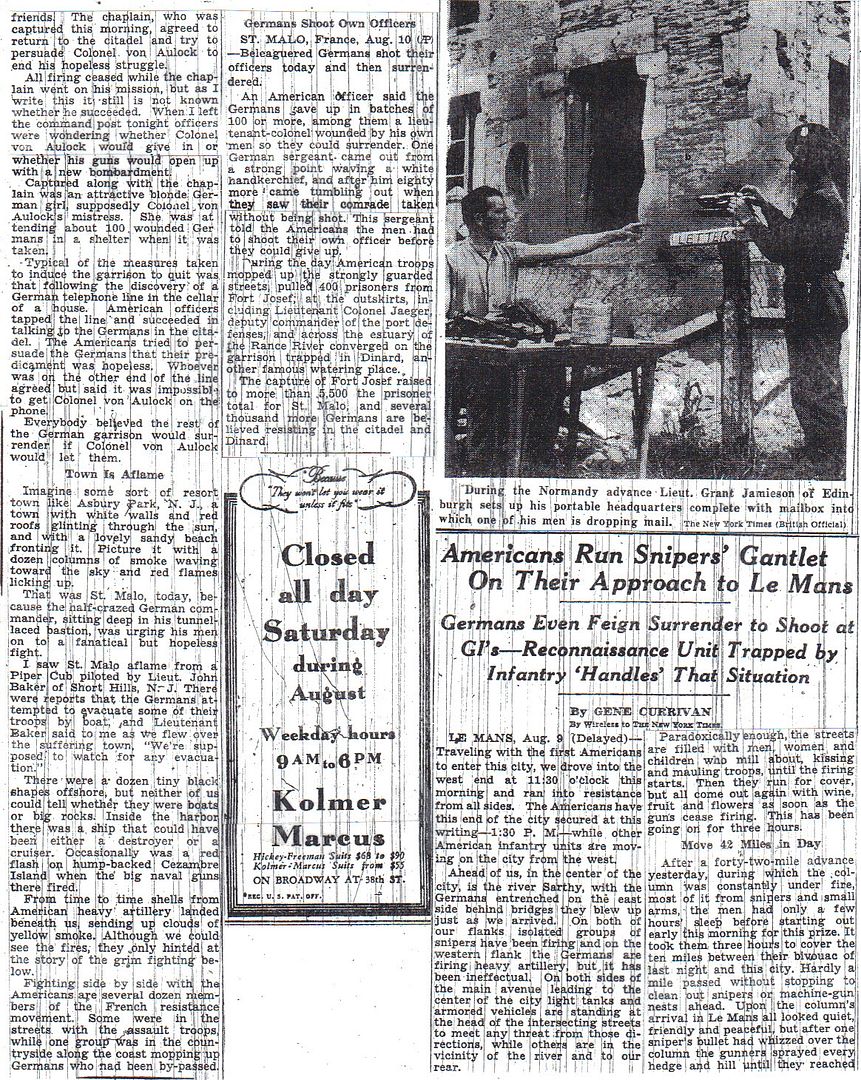
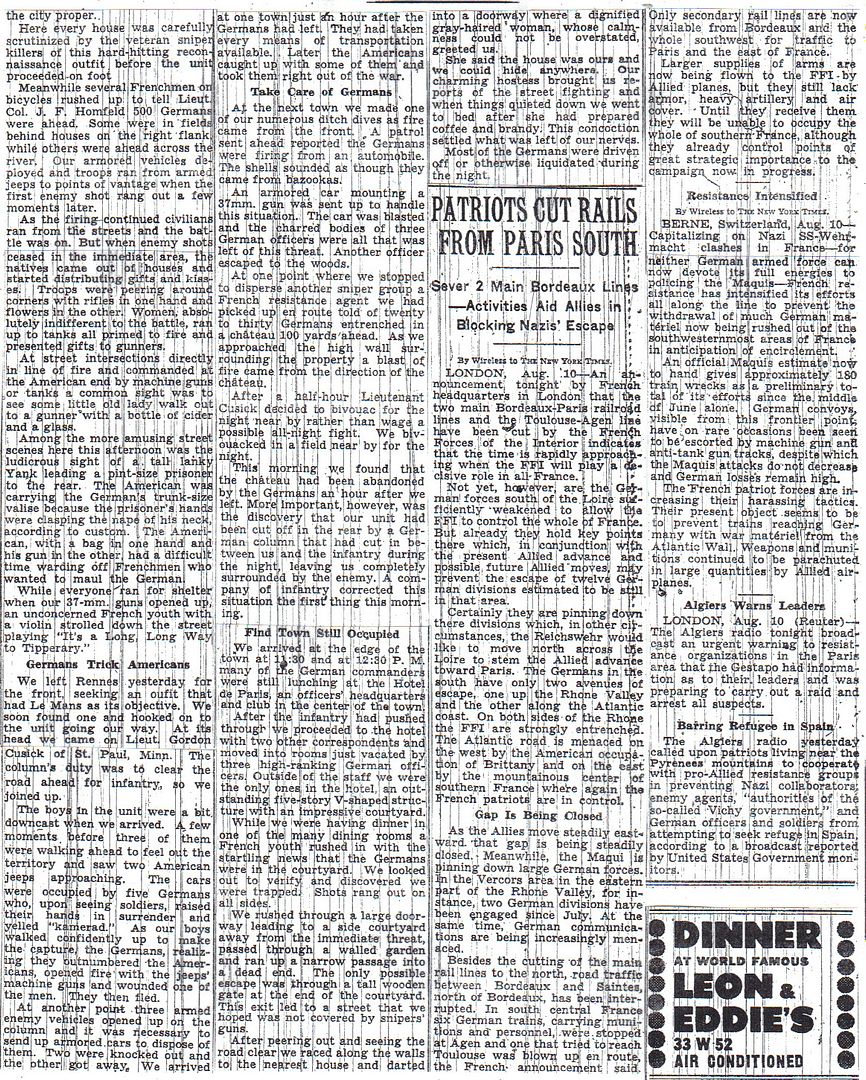

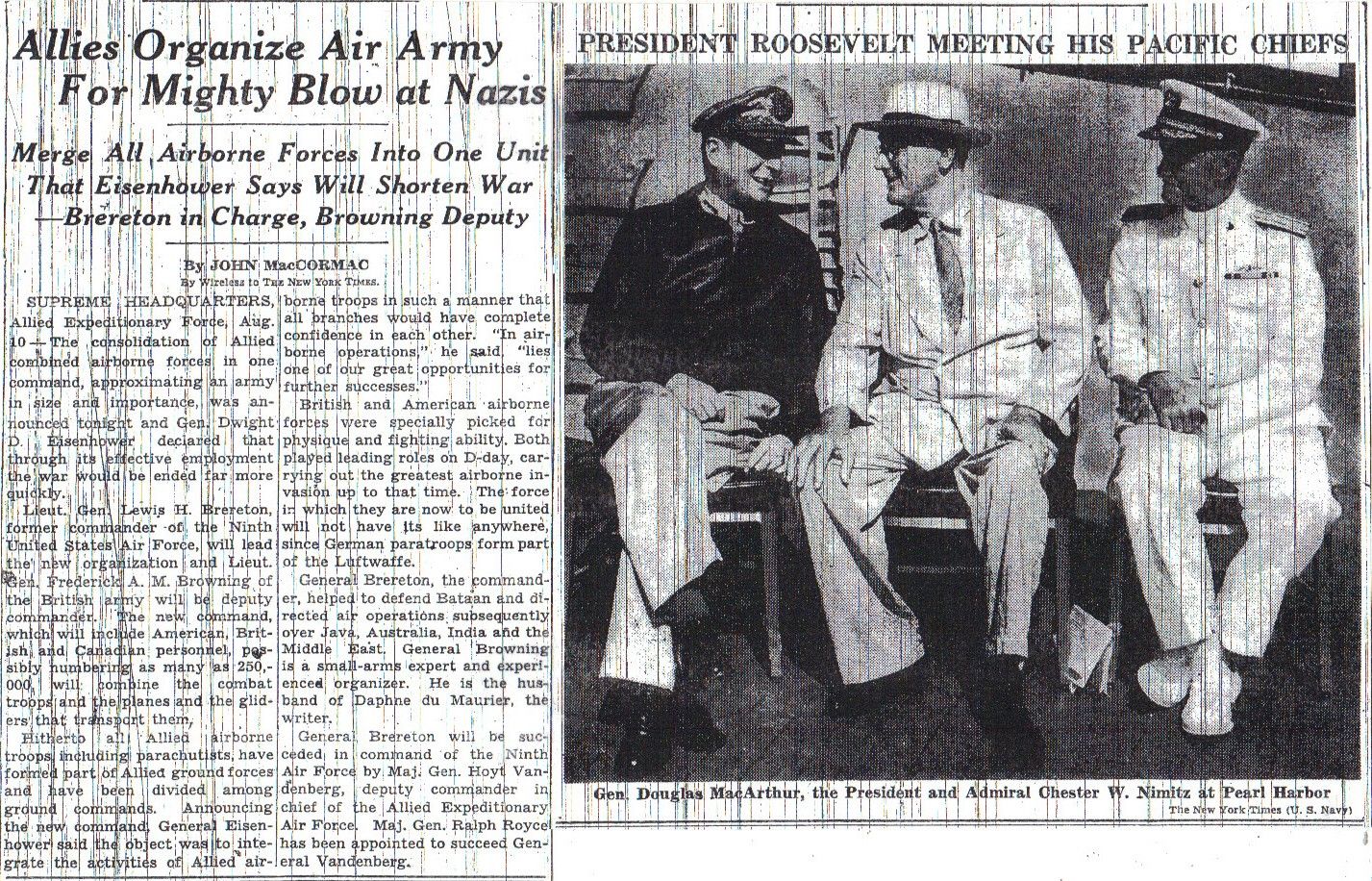
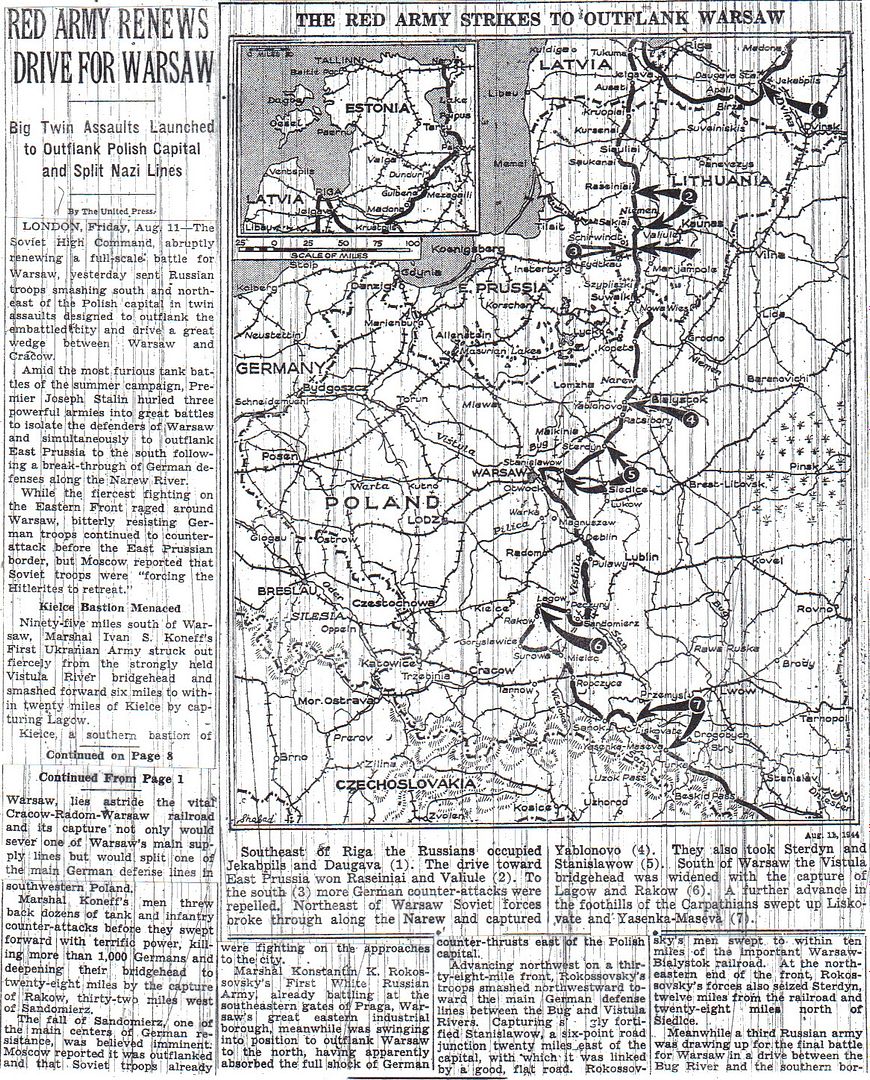
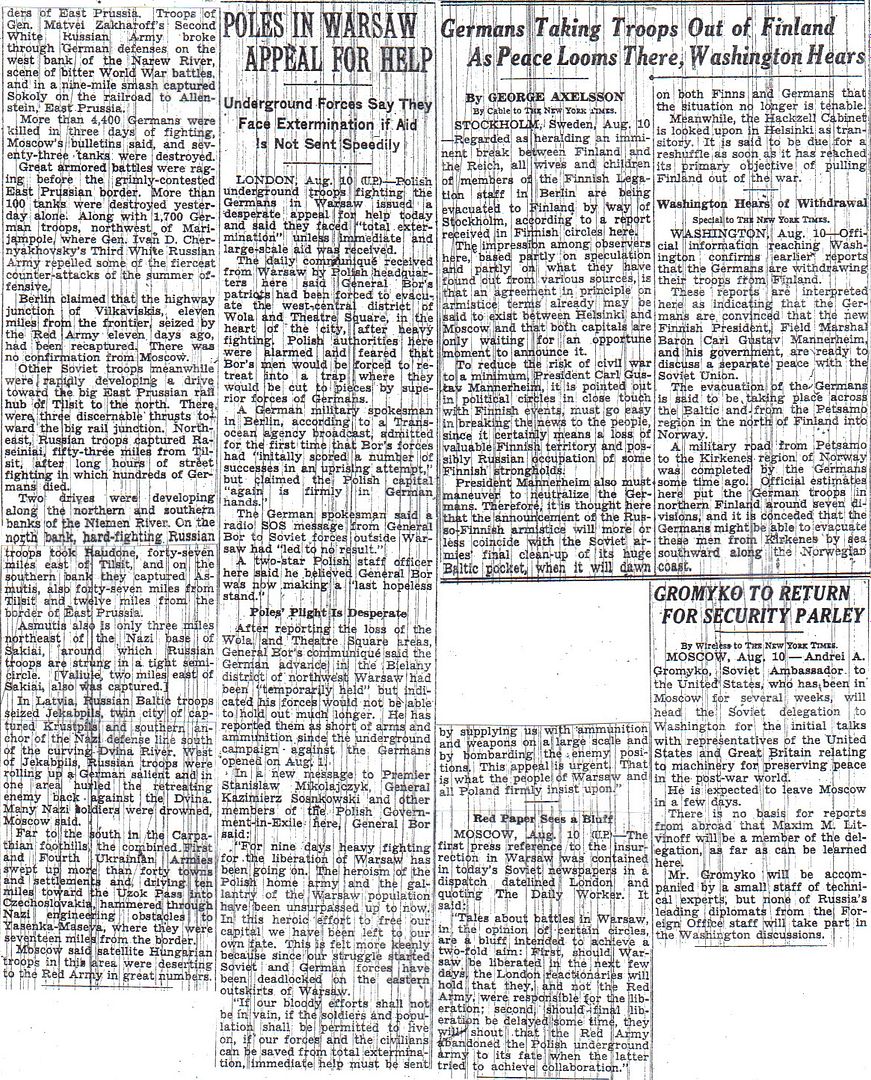
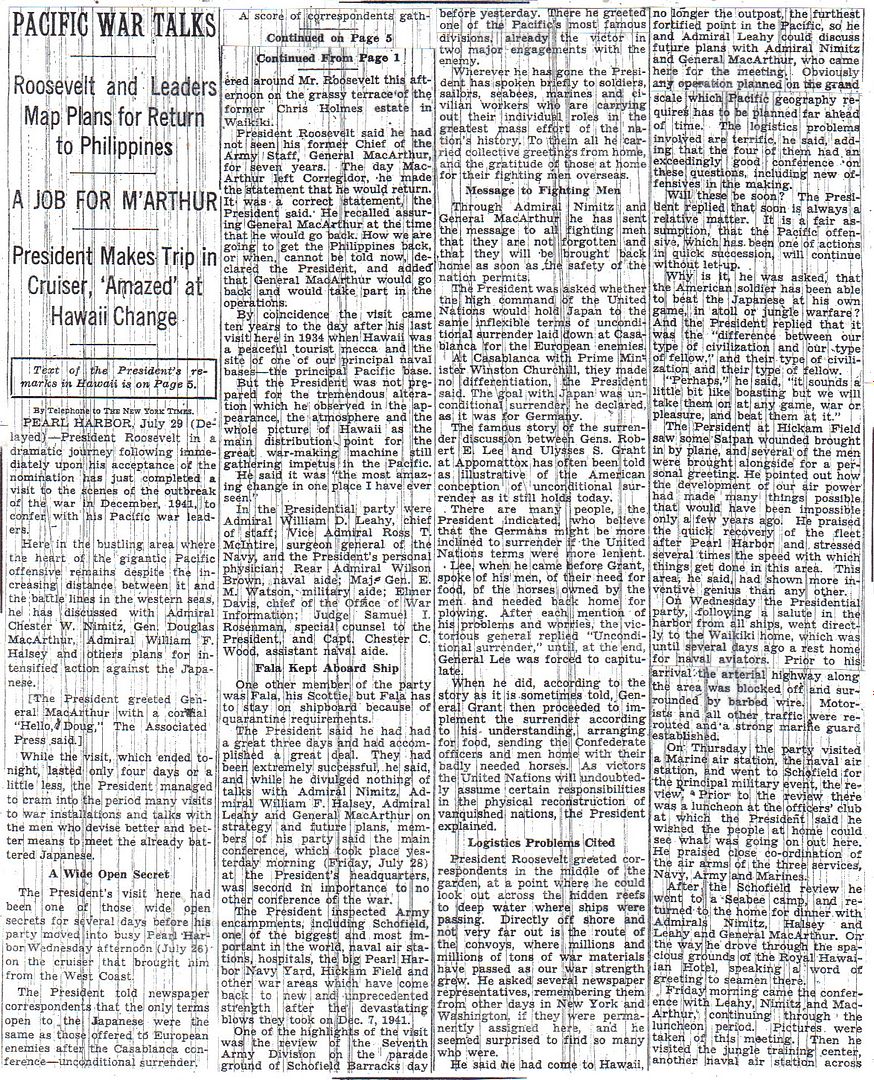
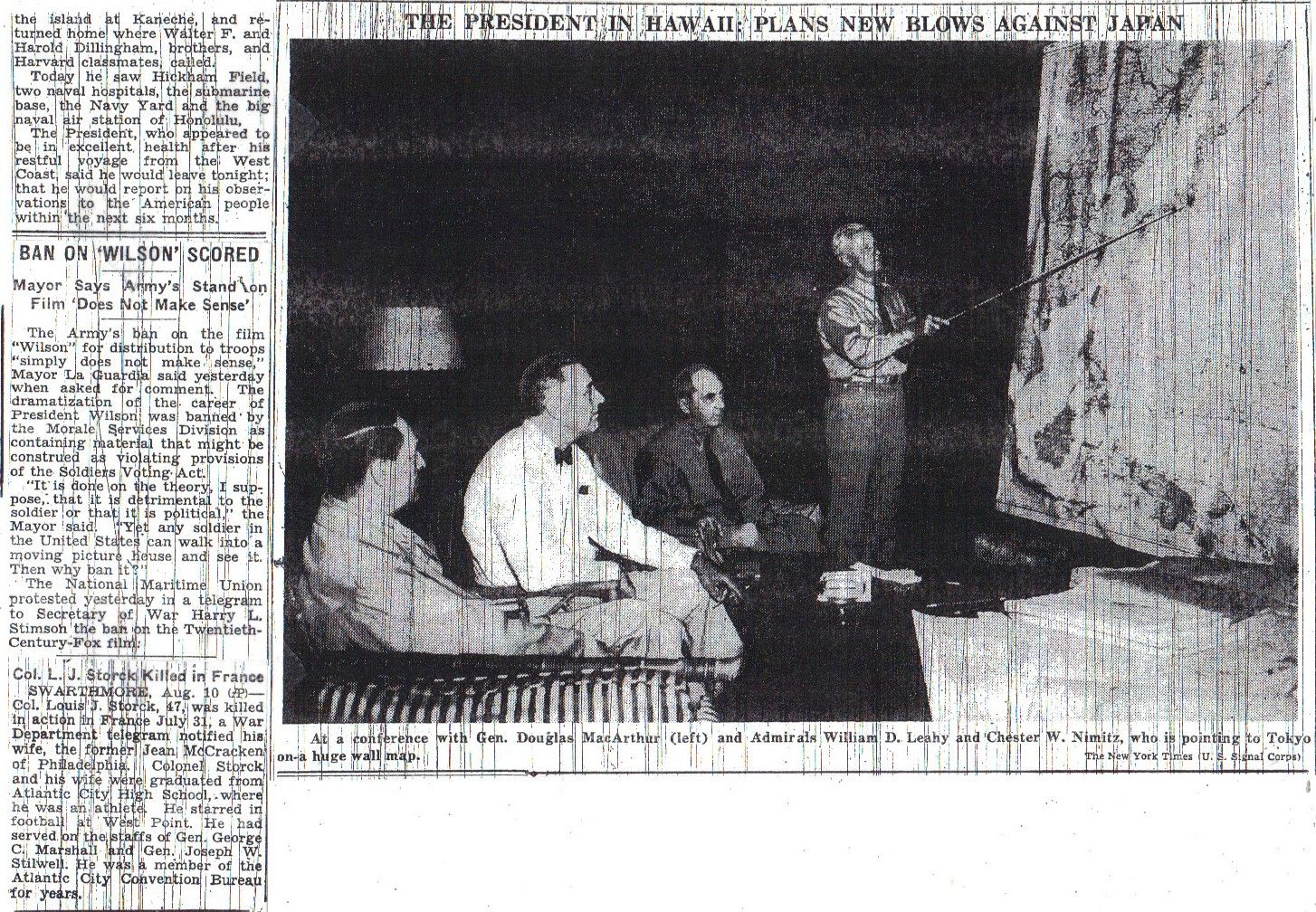

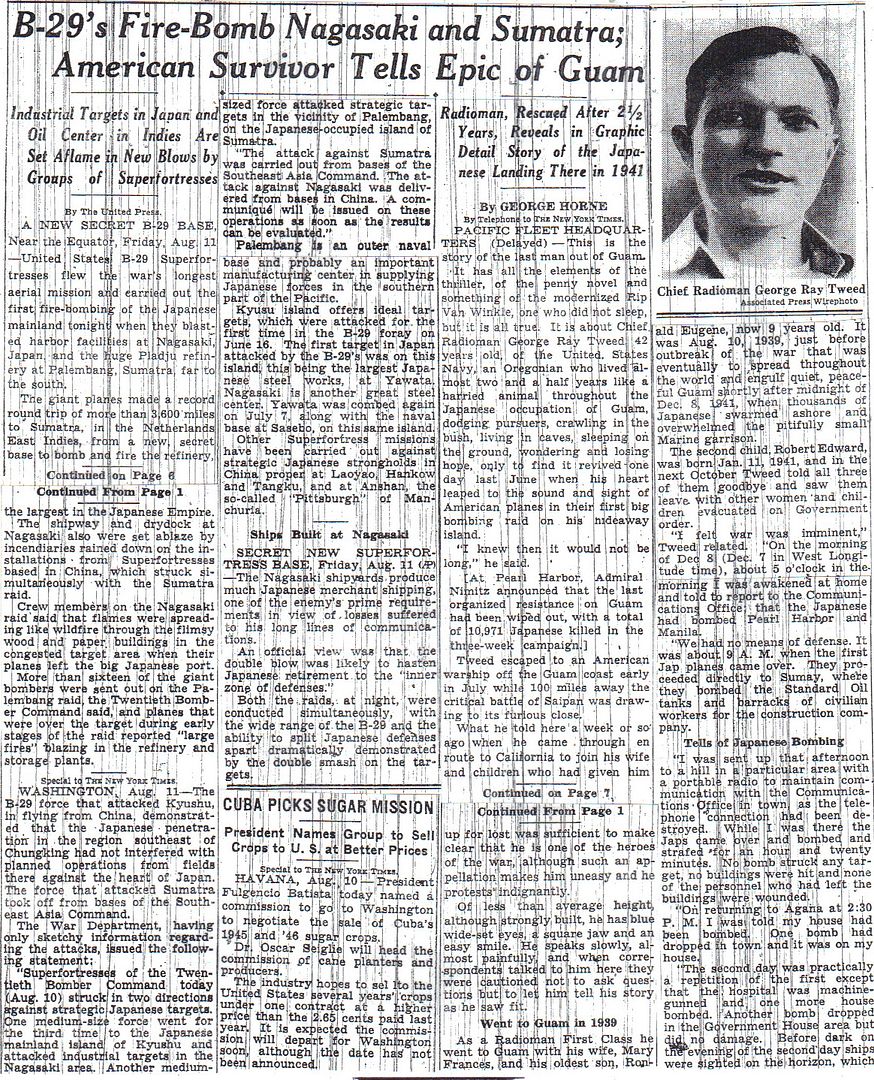
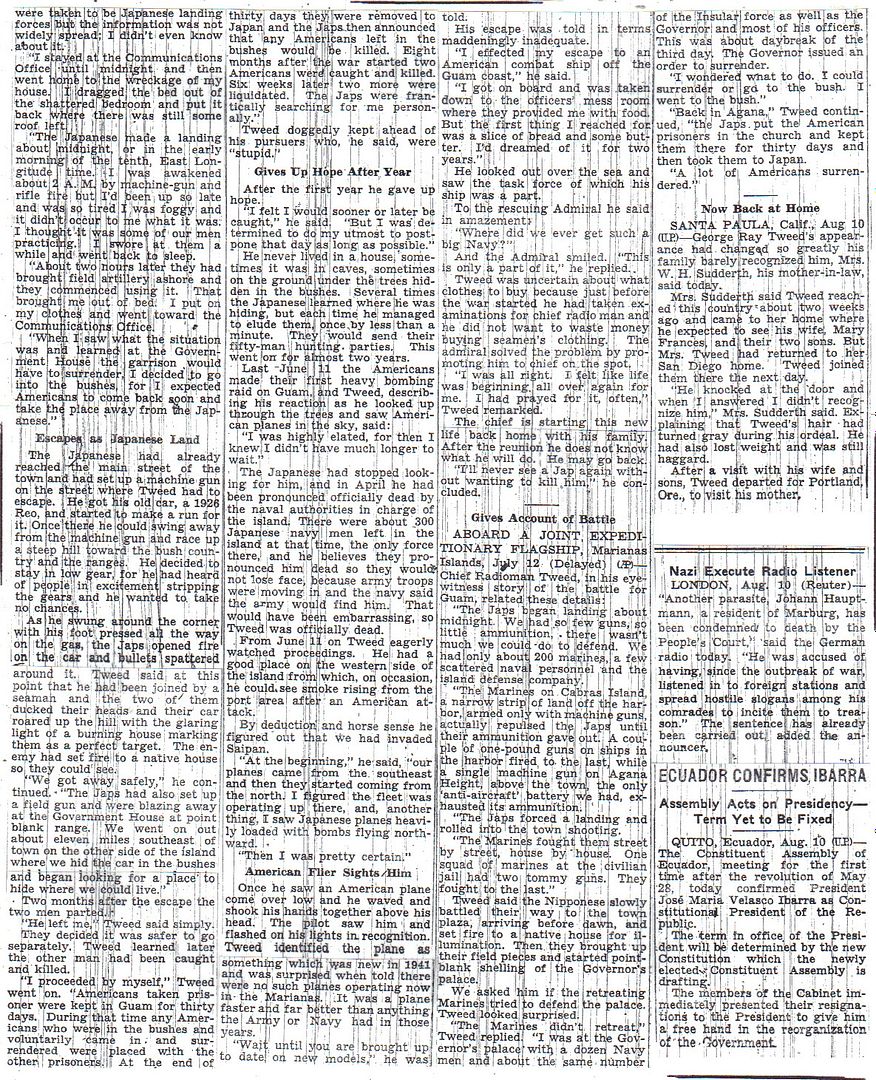
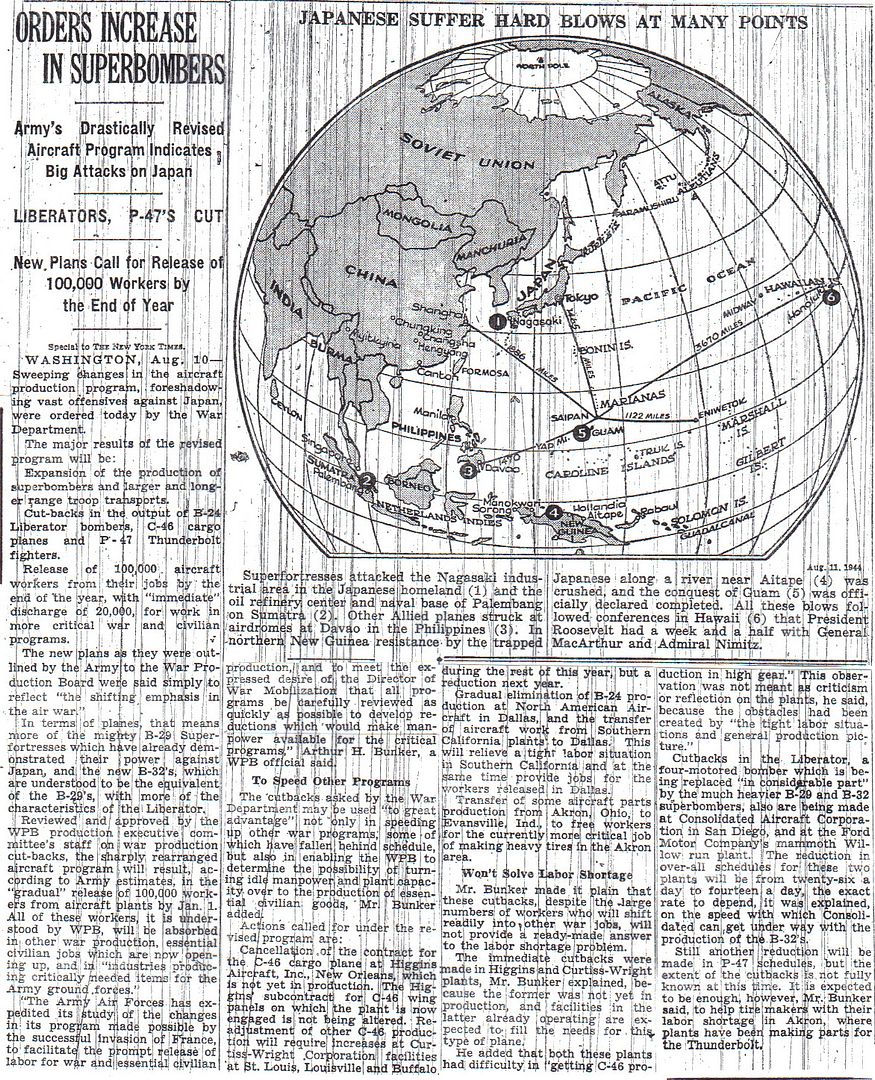

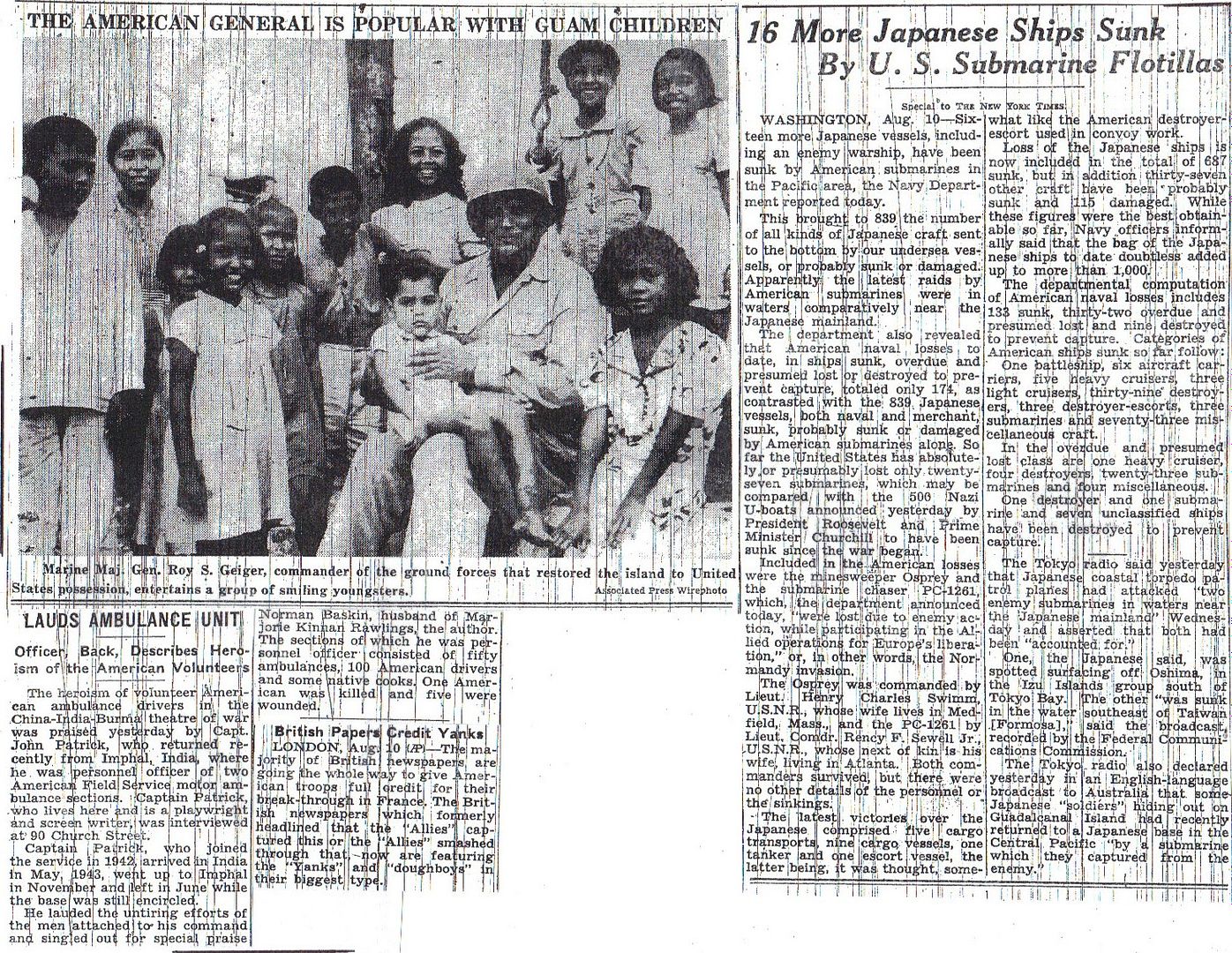
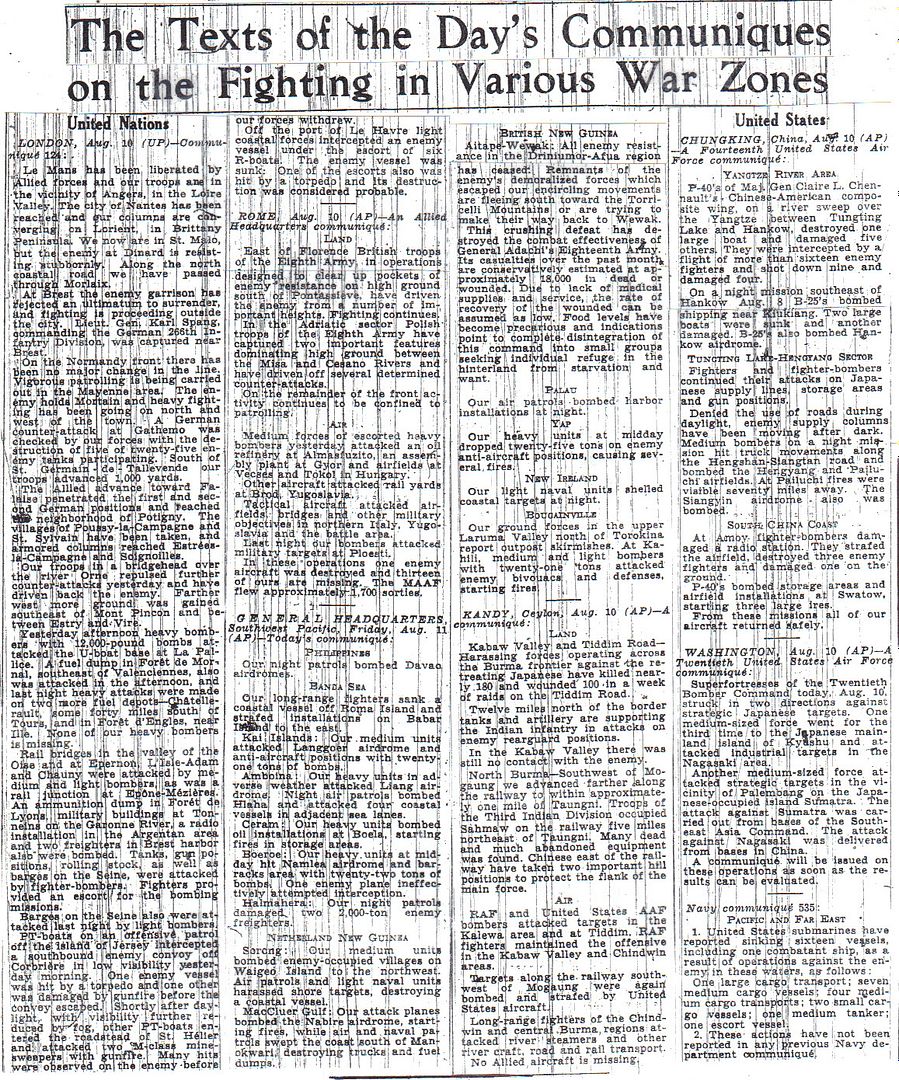
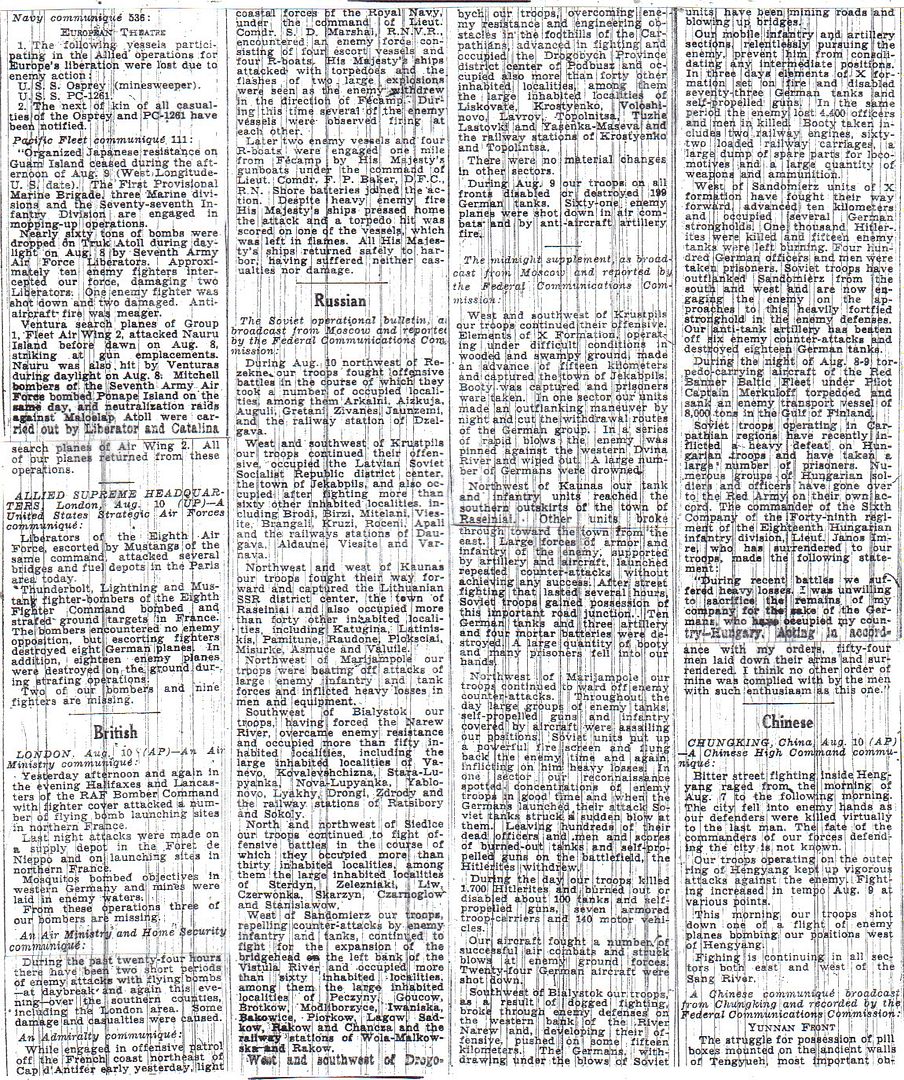
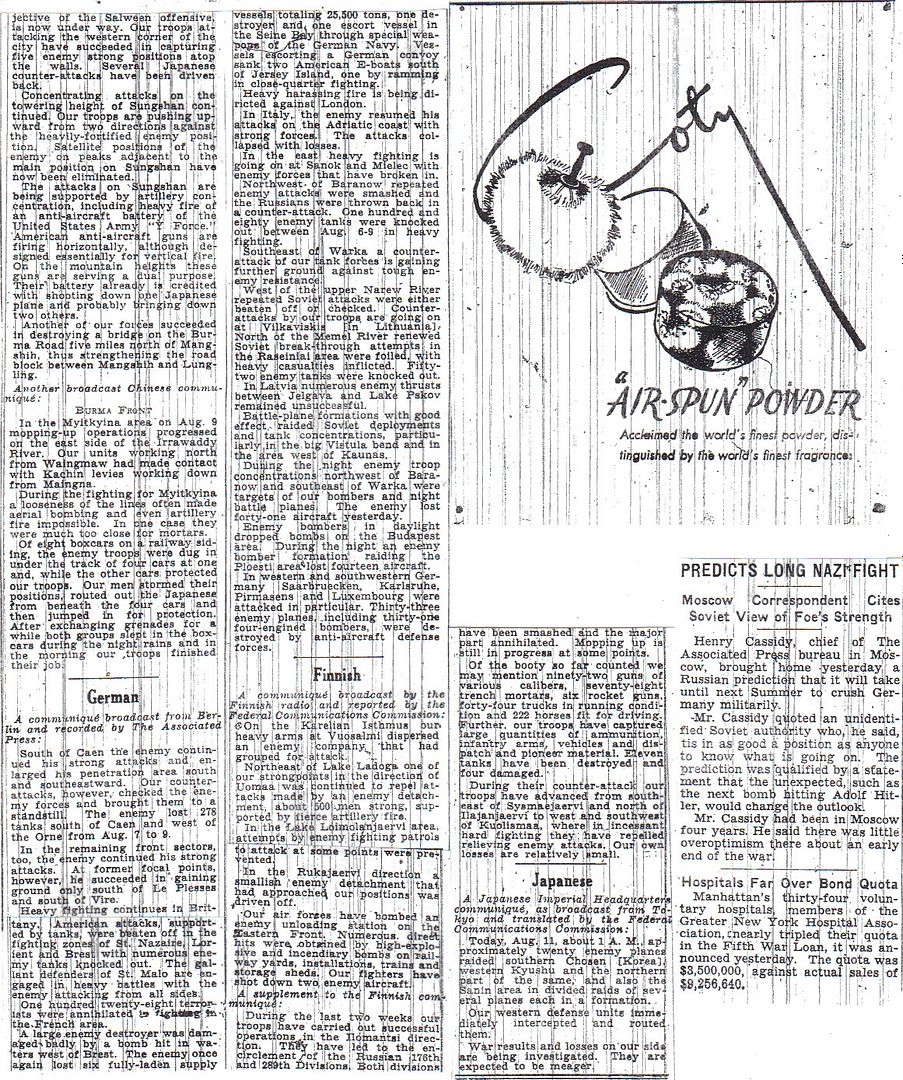
http://www.onwar.com/chrono/1944/aug44/11aug44.htm#
Soviet offensive in the Baltics
Friday, August 11, 1944 www.onwar.com
On the Eastern Front... In the north, the Soviet 3rd Baltic Front begins a new offensive south of Lake Peipus. German forces are unable to withstand the attacks and advances of up to 15 miles are recorded to the west and northwest.
On the Western Front... Elements of US 3rd Army cross the Loire River.
From Berlin... Hitler refuses to allow Field Marshal Kluge, commanding Army Group B in the west, to withdraw from the advanced positions at Mortain.
http://www.etherit.co.uk/month/thismonth/11.htm
August 11th, 1944 (FRIDAY)
UNITED KINGDOM: The US Eighth Air Force in England flies 3 missions today (numbers in parenthesis indicate number of bombers attacking the target).
- Mission 541: 660 bombers and 300+ fighters, in 5 forces, are dispatched to attack 13 marshalling yards, fuel dumps, airfields, and targets of opportunity, in northeastern France and the Paris area; 4 bombers are lost
(1) B-17 Flying Fortresses attack Belfort (76) and Mulhouse (76) marshalling yards and 1 B-17 hit a target of opportunity.
(2) B-24s bomb Coulommiers Airfield (47), Pacy-sur-Armancon (36) and St Florentin (34).
(3) 76 B-17s bomb the Villacoublay aircraft depot; 1 B-17 is lost.
(4) 45 B-24s attack Toussus le Noble Airfield; 9 others hit Saran Airfield at Orleans. (5) B-24s, bomb the Strasbourg fuel dump (66); marshalling yards at Strasbourg (65) and Saarbrucken (60); Nivelles Airfield (10) and 1 hits a target of opportunity; 3 B-24s are lost.
- Mission 542: 275 B-17s attack 23 arsenal areas, barracks, concrete emplacements and heavy artillery posts in and around Brest, France; 1 B-17 is lost. Mission 541 and 542 are escorted by 356 P-38s and P-51 Mustangs; 1 P-51 is lost.
- Mission 543: 1 B-17 flies a Micro H test against La Chenaie rail bridge. Escort is provided by 7 P-47 Thunderbolts.
- Mission 544: 6 B-17s drop leaflets in Franc during the night.
- 165 P-47s fly a fighter sweep of the Paris area; they claim 5-0-0 Luftwaffe aircraft.
- 28 B-24s fly CARPETBAGGER missions in France.
The following Canadian corvettes departed with the 102-ship Londonderry to New York City convoy ON-248S: HMCS Dauphin, Sackville, Halifax and Huntsville. Submarine HMS Scythian commissioned.
FRANCE: Operation Totalize, the Canadian First Army offensive towards Falaise, has failed to break out and is called off.
The 2nd Armoured Battalion Irish Guards are part of a major southward thrust by the Guards Armoured Division to cut the main Vassy-Vire road. Captain ‘Tinker’ Taylor is in command of two troops of tanks which are supporting the Prince of Wales Company, 1st Battalion Welsh Guards, in an attack near the village of Houssemagne, east of Vire.
The tanks rolled forward under heavy shell and mortar fire, keeping pace with 1 Welsh Guards; but as they climbed a long spur towards the Vassy-Vire road, Taylor realised that there were too few infantry to hold the ground unless they were given time to dig themselves in.
He therefore ordered his tanks forward into the orchards on top of the ridge; but the German anti-tank guns were already in position covering the crest, and Taylor’s tank was the first to be knocked out.
Sergeant Garland, one of his troop commanders, accelerated ahead to engage the anti-tank gun and give Taylor and his crew a chance to escape. Garland was now in a very exposed position, so Taylor jumped into the next tank, and immediately ordered it forward to support him.
He duly engaged and destroyed the anti-tank gun, but not before it had hit and crippled Garland’s tank. But Garland’s crew continued fighting until all their ammunition had been expended; they then escaped under cover of a smoke screen.
The enemy, which had infiltrated the surrounding orchards with Panther tanks and self-propelled guns, had knocked out six of eight tanks when Taylor’s became bogged down in a stream.
For two hours he stayed with the immobilised machine, in full view and under heavy enemy fire while directing his remaining tanks and preventing all further attempts to penetrate the position.
Only when the Welsh Guards had reported that they were firmly established and he had been given a direct order to withdraw, did Taylor abandon his tank and bring his crew safely back. He was awarded an immediate MC. (Daily Telegraph 5th June, 2003) (Peter Kilduff)
US forces cross the River Loire.
The US Ninth Air Force sends A-20 Havocs and B-26 Marauders to attack bridges at Montrichard, Oissel, Fismes, and Creil/Saint-Maximin, gun defences at Ile de Cezembre and Saint-Malo, and an ammunition dump at Foret de Roumare; fighters cover the assault area, escort IX Bomber Command aircraft, and fly armed reconnaissance in the battle area and extensively over northern France.
GERMANY: Rastenburg: Hitler allows von Kluge’s men to retreat from Mortain, recognizing the failure of his planned counter-attack.
U-2329 launched.
U.S.S.R.: The Red Army begins a new offensive south of Lake Peipus.
The Soviet High Command had announced the opening of a new offensive in the Baltic. It began at dawn yesterday with a heavy artillery barrage in the south-east corner of Estonia. The tanks and infantry of General Maslennikov’s Third Baltic Front attacked as the barrage lifted, and quickly breached the German defences in the Pskov area. The Russians have advanced some 15 miles and have captured the railway town of Pechory, sealing the fate of the 30 German divisions trapped in the Baltic states. These trapped divisions were “doomed to extermination owing to the strategy of the irresponsible Hitler”, according to the captured German Generals von Kurowski and Lindemann who today called on the German people and military command to end the war.
ITALY: The Pope has allowed his concern for the fate of the Polish patriots fighting in Warsaw to be reflected tonight in the Vatican newspaper Osservatore Romano.
In a powerful commentary, the newspaper says: “The Russian advance is meeting no obstacles. When the news indicates there is a battle near some town, it is invariably followed by the entry into its suburbs and its occupation within a few hours. It is only in Warsaw that this does not happen.
“In Warsaw, Poles of the resistance movement have fought and are fighting. It is necessary to ask whether there is any connection between these two facts. Is this a division of the war effort?” The article goes on to ask why it is necessary for the fighters to say “we ask for help from those who owe us help”, and comments bitterly: “This help is not forthcoming ... Why for the past few days have the Russian bulletins ignored the fight in Warsaw?”
Naples: The sight of a familiar figure wearing a homburg hat and a siren suit and waving a big cigar, did much to cheer up British troops here today. Morale has not been good here in the US Fifth and British Eighth Armies, particularly with the headlines at home dominated by events in Normandy and thousands of their comrades taken from the Italian front for the planned operation in the south of France. Churchill has flown here to meet Tito, with whose help he hopes to salvage earlier British plans for a Balkan campaign which the US rejected. He will also learn of a new plan by General Alexander to break through the Gothic line.
KURILE ISLANDS: 4 Eleventh Air Force B-24s and 2 F-7 Liberators bomb Suribachi Airfield on Paramushiru Island. They are attacked by 15-20 Japanese fighters and the Americans claim 3 fighters shot down.
Radar-equipped B-24s of the US Thirteenth Air Force based on Los Negros Island, attack Japanese airfields and defences in the Palau Islands during the night of 11/12 August.
18 B-24s of 30th Bombardment Group leave their airbase at Saipan to bomb Chichi Jima in the Bonin Islands.
CANADA: Tugs HMCS Glenella, Glenfield and Glenvalley launched Kingston Ontario.
Frigate HMCS Loch Achamalt (ex HMS Loch Achamalt) commissioned.
U.S.A.: An electric-powered rescue hoist is installed on a USCG HNS-1 helicopter at CGAS Floyd Bennett Field, New York. During the ensuing 4-day test period, in which flights are conducted over Jamaica Bay, the feasibility of rescuing personnel from the water and of transferring personnel and equipment to and from underway boats is demonstrated. In late September, a hydraulic hoist, which overcomes basic disadvantages of the electric hoist, is installed and successfully tested, leading to its adoption for service use.
Destroyer USS Lofberg launched. Destroyer escort USS George E Davis commissioned. Destroyer USS Leary laid down.
ATLANTIC OCEAN: Two German submarines are sunk:
- U-385 is sunk in the Bay of Biscay west of La Rochelle, France, in position 46.16N, 02.45W, by depth charges from the RN sloop HMS Starling and depth charges from an RAAF Sunderland Mk III of No. 461 Squadron based at Pembroke Dock, Wales. 42 of the crew of 43 survive.
- U-967 is scuttled in Toulon, France. 2 crewmen die.
(From page 2)”Some forty miles farther southwest, in the area of Mortain, American forces threw in a general offensive yesterday against the German Panzers that have been bulldoggedly holding their deepest salient into the Allied line there and gained a mile to a mile and a half.”
***
As posters have observed previously, Mortain was a nasty little battle with many features of future campaigning in Western Europe. Random historical fact: King John of England (the top villain in the Robin Hood stories) was Count of Mortain before all his brothers conveniently predeceased him.
Also, the compound-complex sentence I quoted would never make it into a contemporary newspaper: in spite of the vast expansion of schooling since 1944, reading comprehension levels have declined.
So it is today. Jodl and Hitler have decided to take the mass of armor recently used at Mortain, and assemble it to the east for a counterstroke against XV Corps open flank. Von Kluge, the man on the scene, agrees with the assembly of units, but on his map the green arrows point due east directly toward the XV Corps spearheads. The attack is scheduled for three days from now, on August 14. The problem is that the plans count on 9th Panzer Division holding off two armored and two infantry divisions from XV Corps. That's not going to happen.
The Normandy campaign has become a game of speed and maneuver. The Americans are very mobile and striking quickly. The Germans simply don't have the mobility to react quickly enough. As a result, German units like 9th Panzer are being committed piecemeal and destroyed.
The American subs have been slaughtering Japanese merchant shipping. Every day Nimitz’ diary lists more victims. I suspect the Japanese war economy is struggling with a lack of raw materials.
Someone must have complained that he could not read the maps. The printing got cleaner as of yesterday and the font for place names went to san serif.
.jpg) |
| IU Archives |
| Pyle shares cigarettes. |
Multimedia |
ON THE WESTERN FRONT, August 11, 1944 – I know that all of us correspondents have tried time and again to describe to you what this weird hedgerow fighting in northwestern France has been like.
But I’m going to go over it once more, for we’ve been in it two months and some of us feel that this is the two months that broke the German Army in the west.
This type of fighting is always in small groups, so let’s take as an example one company of men. Let’s say they are working forward on both sides of a country lane, and this company is responsible for clearing the two fields on either side of the road as it advances.
That means you have only about one platoon to a field. And with the company’s understrength from casualties, you might have no more than twenty-five or thirty men in a field.
Over here the fields are usually not more than fifty yards across and a couple of hundred yards long. They may have grain in them, or apple trees, but mostly they are just pastures of green grass, full of beautiful cows.
The fields are surrounded on all sides by immense hedgerows which consist of an ancient earthen bank, waist-high, all matted with roots, and out of which grow weeds, bushes, and trees up to twenty feet high.
The Germans have used these barriers well. They put snipers in the trees. They dig deep trenches behind the hedgerows and cover them with timber, so that it is almost impossible for artillery to get at them.
Sometimes they will prop up machine guns with strings attached, so they can fire over the hedge without getting out of their holes. They even cut out a section of the hedgerow and hide a big gun or a tank in it, covering it with brush.
Also they tunnel under the hedgerows from the back and make the opening on the forward side just large enough to stick a machine gun through.
But mostly the hedgerow pattern is this: a heavy machine gun hidden at each end of the field and infantrymen hidden all along the hedgerow with rifles and machine pistols.
*
Now it’s up to us to dig them out of there. It’s a slow and cautious business, and there is nothing very dashing about it. Our men don’t go across the open fields in dramatic charges such as you see in the movies. They did at first, but they learned better.
They go in tiny groups, a squad or less, moving yards apart and sticking close to the hedgerows on either side of the field. They creep a few yards, squat, wait, then creep again.
If you could be right up there between the Germans and the Americans you wouldn’t see very many men at any one time – just a few here and there, always trying to keep hidden. But you would hear an awful lot of noise.
Our men were taught in training not to fire until they saw something to fire at. But that hasn’t worked in this country, because you see so little. So the alternative is to keep shooting constantly at the hedgerows. That pins the Germans in their holes while we sneak up on them.
The attacking squads sneak up the sides of the hedgerows while the rest of the platoon stay back in their own hedgerow and keep the forward hedge saturated with bullets. They shoot rifle grenades too, and a mortar squad a little farther back keeps lobbing mortar shells over onto the Germans.
The little advance groups get up to the far ends of the hedgerows at the corners of the field. They first try to knock out the machine guns at each corner. They do this with hand grenades, rifle grenades and machine guns.
*
Usually, when the pressure gets on, the German defenders of the hedgerow start pulling back. They’ll take their heavier guns and most of the men back a couple of fields and start digging in for a new line.
They leave about two machine guns and a few riflemen scattered through the hedge, to do a lot of shooting and hold up the Americans as long as they can.
Our men now sneak along the front side of the hedgerow, throwing grenades over onto the other side and spraying the hedges with their guns. The fighting is very close – only a few yards apart – but it is seldom actual hand-to-hand stuff.
Sometimes the remaining Germans come out of their holes with their hands up. Sometimes they try to run for it and are mowed down. Sometimes they won’t come out at all, and a hand grenade, thrown into their hole, finishes them off.
And so we’ve taken another hedgerow and are ready to start on the one beyond.
This hedgerow business is a series of little skirmishes like that clear across the front, thousands and thousands of little skirmishes. No single one of them is very big. But add them all up over the days and weeks and you’ve got a man-sized war, with thousands on both sides being killed.

It was tax-chick and colorado tanker, grumbling a few days ago about "maps being difficult to read." So I called Col. Gen. Jodl and said: "Die Leute murrend, dass die Karten zu Schwierig zu lesen sind." He said: "Hitler stimmt zu; er kann die Karten auch nicht wohl lesen." The upshot of our meeting was that Jodl promised to make the maps more legible. He took respnsibility for this, and for the disaster in Normandy. He made maps Hitler couldn't read.
That arrow pointing NNE out of LeMans certainly dwarfs every other arrow I’ve seen so far. What does it portend? Perhaps the Germans’ belief that this is the Americans’ main attack direction?
A week or two ago I realized these maps were prepared at the direction of Col. Gen. Alfred Jodl, Chief of the OKW Operations Division, and were presented to Hitler at his daily briefings. Jodl “packaged” the information on these maps to try to influence Hitler’s decisions. What is shown and not shown tells what he was trying to sell to his boss. You rightly noticed that there is the big red arrow, which identifies the axis of attack from the open flank of 7th Army. This is in addition to the fact that American XV Corps, with the four component divisions identified, is the only allied unit specifically identified on the map. It’s pretty clear that Jodl sees this as the decisive unit carrying out the decisive stroke in the Normandy Campaign, and wants Hitler to realize it.
I was not grumbling. I was confessing an inadequacy. Nonetheless, please thank Marshal Jodl for me.
Thanks for your cogent explanation—it’s very helpful. By the way, I’ve bookmarked that map link you provided and will be scouring it. Thanks again for that.
By the way, we need to come up with new color name. You know how you go look at paint strips at the paint store and find all the different names they came up with for various shades. “Seafog,” “Harvest,” “Mountain Mist” and “Garbage Bucket” come to mind.
Well, we need to come up with a color for the olive green pencil in Jodl’s pocket. I was thinking “Fantasia” or “In Your Dreams.”
Other suggestions welcomed.
Looks like Roosevelt has lost lots of weight.
Name for the green color on the German maps? How about Puke Green, because if you can't imagine that unit being there you'd just want to throw up?
What you point out is fascinating that Jodl is using these maps to try to shape Hitler's thinking. Today he is screaming that the XV Corps advance on their exposed southern flank is endangering the Germans' entire Normandy position. It's interesting that the Army is putting out a bit of disinformation about just where XV Corps will go next, but Jodl knows exactly where they are going, which is just what he would have done.
The meeting between Roosevelt and MacArthur and Nimitz was to decide the next Pacific objective, the Philippines or leapfrog to Formosa? MacArthur was strongly for the Philippines and at the time Nimitz was for Formosa. At the time they were still thinking of trying to seize a major Chinese port, for which Formosa is more strategically placed, and Formosa could be a staging area for the invasion of Japan. Characteristic for Roosevelt, no decision was made and it won't be made for more than a month. Eventually, the idea of a major land operation on the China coast will be abandoned and people will come to see Okinawa would be an easier take and would serve as the base for operations in Japan.
Great story about Chief Radioman George Tweed surviving on the run for more than two years on Guam. There must have been plenty of times he thought he would never see his wife and kids again.
The B-32 was to be a Liberator on steroids and was to go into development in parallel with the B-29 in case that design didn't pan out. As it turned out, the B-29 was a great success, but the B-32 could never overcome its own design problems and never went into mass production.
The decision of the Philippines vs. Formosa is probably the one and only time I am in agreement with MacArthur over Nimitz.
From a military standpoint, the Philippines were a lot tougher for the Japanese to defend than Formosa. All of the scattered islands of the archipelago, and the Japanese cannot be everywhere. With allied air power, we can isolate any one of those islands. Also, the natives are friendly toward us and hostile to the Japanese. They will be a great source of intelligence and support. The Philippines also provide the base that will completely shut off the Japanese from their oil sources. That’s why the Japanese attacked us in 1941; they could not allow our presence in the Philippines to lie athwart their communications and sea lanes.
Formosa, on the other hand, would have been a tough nut to crack. The Japanese had been there since 1895, and the population had been thoroughly pacified. They had many substantial military installations in place, and the terrain favored the defense. Formosa is a fairly large island, and it would have taken a long time and many, many casualties to capture it. It would have provided few advantages over the Philippines.
Finally, MacArthur was absolutely correct regarding the implications to the post-war world if we had passed over the Philippines. We had a stake in the Philippines, and if we passed up liberating them, our word would have meant very little to prospective allies in the region when it came to combating communism.
So I side completely with MacArthur on this one. But this time and only this time.
Disclaimer: Opinions posted on Free Republic are those of the individual posters and do not necessarily represent the opinion of Free Republic or its management. All materials posted herein are protected by copyright law and the exemption for fair use of copyrighted works.